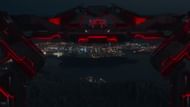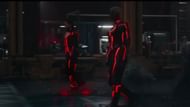Tron: Ares brings the digital universe back to life with a new story that stands on its own. The movie follows refreshing characters as they navigate between the Grid and reality. But beneath its modern surface, the film carries the DNA of everything that came before. Like hidden code waiting to be discovered, minor details connect this chapter to the franchise's origins. Tron: Ares does not just tell a new tale. It honours the past through clever nodes and visual echoes.
These references function like threats within a larger tapestry. Some jump out immediately. Others hide in plain sight, waiting for sharp eyes to catch them. The movie strikes a balance between innovation and nostalgia, creating a world that feels both new and familiar. For longtime viewers, these moments add additional layers of meaning. They transform ordinary scenes into something dense.
Here are some easter egg references from the movie that will leave the viewers shocked.
7 easter eggs from Tron: Ares that you probably missed
1) The orange makes a comeback

At the beginning of Tron: Ares, an orange becomes central to the story of the narrative. This is not randomly added to the plot. The former Tron utilized an orange to test digitization.
The fruit symbolizes a bridge between digital space and natural life. In this new movie, the process goes on in reverse mode. Eve experiments with making digital constructs permanent in the physical realm in Tron: Ares. She utilizes an orange tree as proof of concept.
The successful creation of organic matter mirrors what Flynn achieved years earlier. This simple fruit becomes a symbol of technological evolution. It displays how far the experiments have progressed. The circle completes itself through this minor but meaningful detail.
2) Flynn's server looks retro

In the movie, when Ares enters Flynn's private server, something shifts. The modern CGI disappears. In its place, the blocky computer graphics from 1982 make a comeback.
The visual shift is not just a matter of nostalgia. It represents the Grid frozen in time. Every version of God has evolved with the development of technology. Tron: Legacy displayed polished and sleek visuals.
Tron: Ares continues that trend in most sequences. But Flynn's personal space remains untouched by growth. The dated aesthetic creates a time capsule effect. It reminds audiences where everything started. The contrast between the new and old styles highlights the significant transformation that has occurred. Yet some things remain preserved exactly as they were.
3) Bit pops up again

Inside the server of Flynn in Tron: Ares, a familiar face shows up. Bit arrives to greet with its signature responses. The geometric program can only communicate through one-syllable sounds, such as "yes" and "no".
In the original Tron, Bit served as a tool for comic relief. It helped the heroes navigate the digital landscape. Here, Bit guides Ares through the Flynn domain. It serves him with a classic Lightcycle. Then it leads him toward the digital version of Flynn. The role is small but significant. Bit's comeback acknowledges the character's place in the franchise's history. For viewers who remember the former, this moment brings a smile.
4) Flynn appears as a guru

Tron: Ares comes with a digital copy of Kevin Flynn. The version carries the same spiritual energy displayed in Tron: Legacy. The older Flynn lived as a hermit after his creation did not take his side. He adopted a zen-like philosophy while trapped in isolation. The copy in Tron: Ares keeps that aesthetic and personality. He speaks with the same casual language and wisdom Flynn used in the first movie.
His presence creates interesting questions about consciousness and identity. This is not the same Flynn who sacrificed himself. But he feels real to what came formally. The character bridges different eras of the franchise through his mannerisms and appearance.
5) The Dumont company still exists

After a bad Lightcycle chase, Eve crashes into a dumpster. A sign reveals it belongs to the Dumont Company. This detail connects to Tron: Legacy. In that movie, Sam Flynn lived in a covert shipping container. The container originated from the same company. The name references Dumont, a helpful character from the former Tron.
The repeated mention suggests that the Dumont company has evolved successfully and has grown large. It became a major corporation in this universe. These small touches build the universe beyond what viewers see on screen. They suggest history and continuity without lengthy explanations.
6) A fan cosplays as Tron

In Tron: Ares, during an ENCOM panel, the camera briefly displays the crowd. One attendee wears a costume designed to look like Tron. This quick moment reveals something essential. In this world, people recognize Tron as a video game character.
They fail to realize that actual events inspired the games. The public treats the digital adventures as pure fiction. This cosplayer embodies the notion that the truth has been concealed. The general population stays unaware of what actually happened. They consume entertainment without understanding its former origin. This minor detail adds depth to how the surroundings function.
7) Flynn's Arcade contains history

Flynn's Arcade makes a comeback in Tron: Ares as a meaningful location. The building shut down long ago, but it preserves a crucial part of history. Inside, a poster hangs on the wall. It mimics the former Tron film poster from 1982. This represents how the arcade became almost sacred ground.
The in-universe game in Tron: Ares continues to keep intact the cultural significance. When Ares gains permanence and crosses into reality, this is where he comes. The arcade serves as a threshold between the universe. It's where the physical and digital worlds collide. The poster reinforces that this place was the starting point of everything.
Tron: Ares weaves its story with vigilant attention to what came formerly. These references create bridges across years. They reward dedicated fans while remaining accessible to newcomers. The movie proves that looking forward does not mean forgetting what was in the past.
